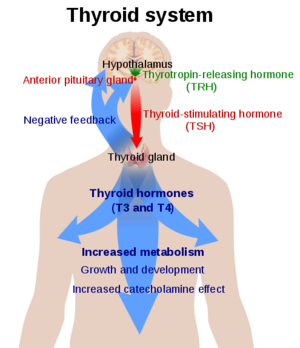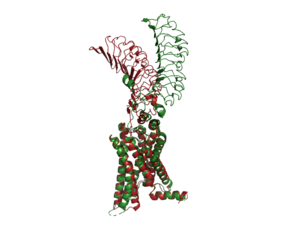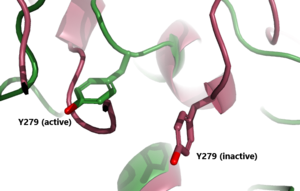Sandbox Reserved 1791
From Proteopedia
(Difference between revisions)
| Line 33: | Line 33: | ||
== Biological Relevance == | == Biological Relevance == | ||
[[Image:TSH role.jpeg|400 px|right|thumb|(Fig. 3) TSH’s role in the diagnosis of Hyperthyroidism and Hypothyroidism: [https://labpedia.net/thyroid-part-1-thyroid-function-test-thyroid-hormones-t4-t3-tsh-metabolism-and-role-of-tsh/]]] | [[Image:TSH role.jpeg|400 px|right|thumb|(Fig. 3) TSH’s role in the diagnosis of Hyperthyroidism and Hypothyroidism: [https://labpedia.net/thyroid-part-1-thyroid-function-test-thyroid-hormones-t4-t3-tsh-metabolism-and-role-of-tsh/]]] | ||
| - | The thyroid plays an essential role in the body's metabolism. The body's metabolism affects things like heart rate, digestion, temperature regulation, and many more things. When TSH is bound to TSHR, a signal is sent to produce T3 and T4. Those hormones then go impact cells in your body to increase or decrease your metabolism. | + | The thyroid plays an essential role in the body's metabolism. The body's metabolism affects things like heart rate, digestion, temperature regulation, and many more things. When TSH is bound to TSHR, a signal is sent to produce T3 and T4. T4 is considered an inactive form and needs to be converted into T3 to become active. Those hormones then go impact cells in your body to increase or decrease your metabolism. The T3 and T4 hormones use a feedback system to regulate the release of TSH. When the hormone levels are high they travel through the bloodstream to prevent TSH production. When the hormones are low they are not able to continue the negative feedback loop, thus allowing TSH to be released to bind to TSHR. |
=== Hyperthyroidism === | === Hyperthyroidism === | ||
[https://www.mayoclinic.org/diseases-conditions/hyperthyroidism/symptoms-causes/syc-20373659 Hyperthyroidism] is when the thyroid is overactive. When the M22 antibody is bound it keeps TSHR in the active conformation. This overstimulates the body's metabolism. Symptoms of hyperthyroidism include but are not limited to fast or irregular heartbeats, tiredness, increased hunger, sleep problems, enlarged thyroid gland, and sensitivity to heat. [https://www.niddk.nih.gov/health-information/endocrine-diseases/graves-disease Grave's Disease] is the most common cause of hyperthyroidism. This is an autoimmune disorder that causes your body to attack the thyroid gland<ref name="Luca">Chiovato L, Magri F, Carlé A. Hypothyroidism in Context: Where We've Been and Where We're Going. Adv Ther. 2019 Sep;36(Suppl 2):47-58. doi: 10.1007/s12325-019-01080-8. Epub 2019 Sep 4. PMID: 31485975; PMCID: PMC6822815. [DOI: 10.1007/s12325-019-01080-8 https://pubmed.ncbi.nlm.nih.gov/31485975/]</ref>. | [https://www.mayoclinic.org/diseases-conditions/hyperthyroidism/symptoms-causes/syc-20373659 Hyperthyroidism] is when the thyroid is overactive. When the M22 antibody is bound it keeps TSHR in the active conformation. This overstimulates the body's metabolism. Symptoms of hyperthyroidism include but are not limited to fast or irregular heartbeats, tiredness, increased hunger, sleep problems, enlarged thyroid gland, and sensitivity to heat. [https://www.niddk.nih.gov/health-information/endocrine-diseases/graves-disease Grave's Disease] is the most common cause of hyperthyroidism. This is an autoimmune disorder that causes your body to attack the thyroid gland<ref name="Luca">Chiovato L, Magri F, Carlé A. Hypothyroidism in Context: Where We've Been and Where We're Going. Adv Ther. 2019 Sep;36(Suppl 2):47-58. doi: 10.1007/s12325-019-01080-8. Epub 2019 Sep 4. PMID: 31485975; PMCID: PMC6822815. [DOI: 10.1007/s12325-019-01080-8 https://pubmed.ncbi.nlm.nih.gov/31485975/]</ref>. | ||
Revision as of 17:12, 7 April 2023
| This Sandbox is Reserved from February 27 through August 31, 2023 for use in the course CH462 Biochemistry II taught by R. Jeremy Johnson at the Butler University, Indianapolis, USA. This reservation includes Sandbox Reserved 1765 through Sandbox Reserved 1795. |
To get started:
More help: Help:Editing |
Thyroid Stimulating Hormone Receptor (TSHR)
| |||||||||||
References
- ↑ 1.0 1.1 1.2 1.3 Faust B, Billesbolle CB, Suomivuori CM, Singh I, Zhang K, Hoppe N, Pinto AFM, Diedrich JK, Muftuoglu Y, Szkudlinski MW, Saghatelian A, Dror RO, Cheng Y, Manglik A. Autoantibody mimicry of hormone action at the thyrotropin receptor. Nature. 2022 Aug 8. pii: 10.1038/s41586-022-05159-1. doi:, 10.1038/s41586-022-05159-1. PMID:35940205 doi:http://dx.doi.org/10.1038/s41586-022-05159-1
- ↑ Duan J, Xu P, Luan X, Ji Y, He X, Song N, Yuan Q, Jin Y, Cheng X, Jiang H, Zheng J, Zhang S, Jiang Y, Xu HE. Hormone- and antibody-mediated activation of the thyrotropin receptor. Nature. 2022 Aug 8. pii: 10.1038/s41586-022-05173-3. doi:, 10.1038/s41586-022-05173-3. PMID:35940204 doi:http://dx.doi.org/10.1038/s41586-022-05173-3
- ↑ Fokina, E.F., Shpakov, A.O. Thyroid-Stimulating Hormone Receptor: the Role in the Development of Thyroid Pathology and Its Correction. J Evol Biochem Phys 58, 1439–1454 (2022). [DOI:10.1134/S0022093022050143 https://doi.org/10.1134/S0022093022050143]
- ↑ Smits G, Govaerts C, Nubourgh I, Pardo L, Vassart G, Costagliola S. Lysine 183 and glutamic acid 157 of the TSH receptor: two interacting residues with a key role in determining specificity toward TSH and human CG. Mol Endocrinol. 2002 Apr;16(4):722-35. doi: 10.1210/mend.16.4.0815. PMID: 11923469. [DOI: 10.1210/mend.16.4.0815 https://pubmed.ncbi.nlm.nih.gov/11923469/]
- ↑ 5.0 5.1 Chiovato L, Magri F, Carlé A. Hypothyroidism in Context: Where We've Been and Where We're Going. Adv Ther. 2019 Sep;36(Suppl 2):47-58. doi: 10.1007/s12325-019-01080-8. Epub 2019 Sep 4. PMID: 31485975; PMCID: PMC6822815. [DOI: 10.1007/s12325-019-01080-8 https://pubmed.ncbi.nlm.nih.gov/31485975/]



![(Fig. 3) TSH’s role in the diagnosis of Hyperthyroidism and Hypothyroidism: [1]](/wiki/images/thumb/9/95/TSH_role.jpeg/400px-TSH_role.jpeg)
